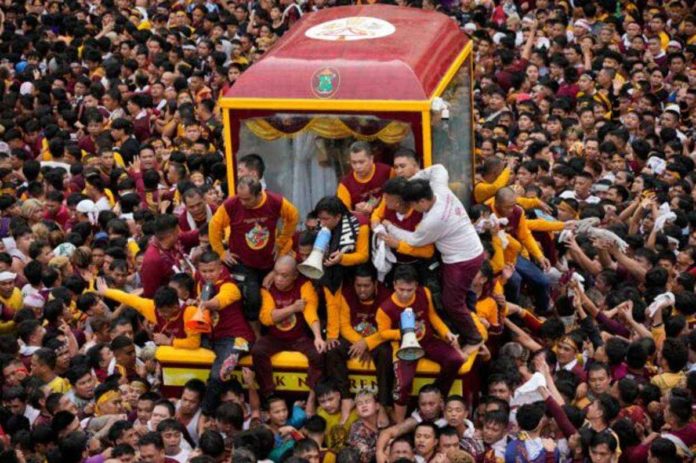
MANILA – Around 6.5 million Catholic devotees turned up for this year’s procession to honor the Black Nazarene on Jan. 9, turning the streets of Manila into a sea of maroon and yellow, in one of the world’s biggest displays of religious devotion.
The 15-hour procession began at 4:45 a.m. following an outdoor mass at the Quirino Grandstand in Manila and concluded at 7:45 p.m. when the life-size statue of a dark-skinned Jesus Christ returned to the Minor Basilica of the Black Nazarene in Quiapo.
The Black Nazarene, believed by many Filipinos to possess miraculous healing abilities, draws crowds seeking to touch it or the ropes on its float for cures and good fortune.
“I believe that the Nazarene will give what we are all praying for — we just have to wait, but he will give everything,” said Renelinda de Leon, 64, at the procession’s start. “He gave me good health. I don’t have an illness, I’m always healthy.”
As a drizzle covered the crowd, some barefoot devotees clambered over others and grabbed guards’ clothes to reach the float, leading to falls.
Other guards on the float pushed unruly followers to the ground to protect the icon, encased in glass, allowing the parade to proceed.
Over 15,000 security and medical staff were deployed along the route.
First after the pandemic
This is the first traditional parade featuring the life-size statue since 2020, paused due to Covid-19.
The Quiapo Church Command Center reported that 657,000 devotees initially joined the religious procession at the Quirino Grandstand. The crowd increased to 833,000 by 7:44 a.m., and further swelled to 1,340,000 a few hours later.
Jonathan Rancho, 52, joined with his family from Bulacan province.
“I am very pleased the old system is back and we get to do this again,” he said, hoping for improved livelihoods and success.
Marites Rote credited the Black Nazarene with curing her children’s skin rashes nearly 40 years ago and more recently, helping pay her husband’s medical bills.
“When my husband got sick we were penniless, but because of the Nazarene we were able to provide for his needs,” Rote, 60, said.
Authorities, citing no specific threat, blocked mobile signals to prevent remote detonations. They also imposed a no-fly and no-sail zone in the areas surrounding the Quirino Grandstand and Quiapo Church, Pasig River, as well as along the procession routes, from January 7 to 10.
The Traslacion, previously taking up to 22 hours, saw over 640 devotees receive medical help as of 6 p.m., the Philippine Red Cross reported. First-aid stations treated 214 people for minor medical issues, and addressing six cases with major issues.
Some devotees collapsed and were carried out or passed over others’ heads. Thirty-two individuals required transport to nearby hospitals and medical facilities. (Adrian Parungao, Charie Abarca, Faith Argosino, Gabriel Lalu, John Eric Mendoza, Luisa Cabato, Zacarian Sarao, Zeus Legaspi © Philippine Daily Inquirer, Agence France-Presse, Associated Press, Reuters)






